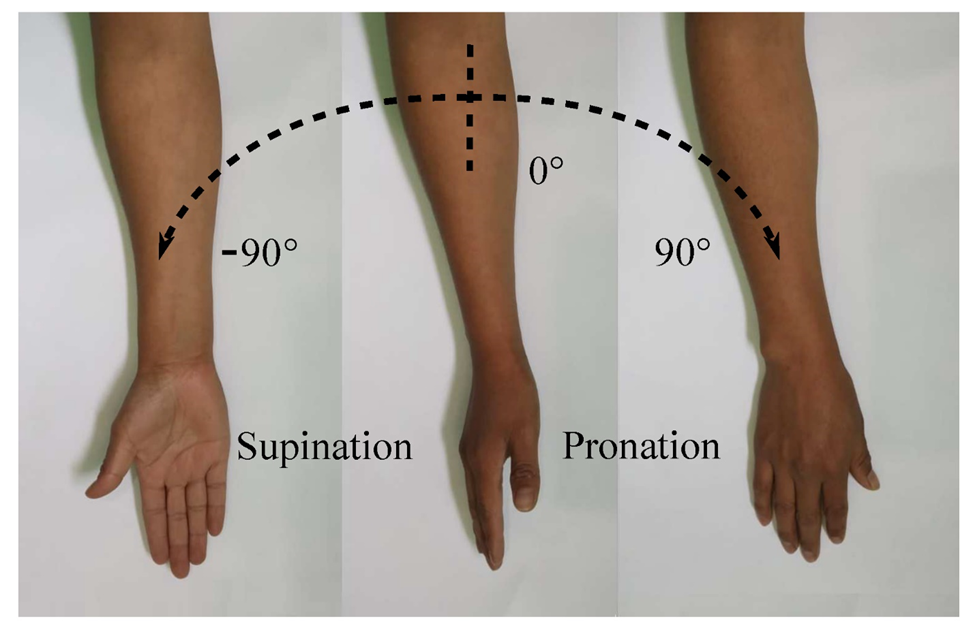A nurse is collecting data about a client’s range of motion. Which of the following instructions should the nurse give to the client to observe the elbow rotate for supination?
“Turn each of your hands and forearms so your palm is facing down.”
“Take each of your hands and touch your shoulders.”
“Turn each of your hands and forearms so your palm is facing up.”
“Move each of your arms to rest at your sides.”
The Correct Answer is C
A. “Turn each of your hands and forearms so your palm is facing down.”
This describes pronation, not supination. In pronation, the palm faces down, and the radius crosses over the ulna.
B. “Take each of your hands and touch your shoulders.”
This describes flexion at the elbow joint, not supination. Flexion involves decreasing the angle between body parts.
C. “Turn each of your hands and forearms so your palm is facing up.”
This is the correct choice. Supination involves turning the hands and forearms so that the palms face up, and the radius and ulna are parallel.
D. “Move each of your arms to rest at your sides.”
This describes adduction, bringing the arms back to the sides of the body, not supination.

Nursing Test Bank
Naxlex Comprehensive Predictor Exams
Related Questions
Correct Answer is C
Explanation
A. The stockings are used to reduce pain.
This statement is not accurate. While antiembolism stockings may provide some relief from discomfort and swelling, their primary purpose is to prevent venous stasis and reduce the risk of blood clots, not to directly reduce pain.
B. The stockings prevent varicose veins.
This statement is not entirely accurate. While compression stockings can provide some support to veins, their primary role is in preventing blood clots (venous thromboembolism) rather than preventing varicose veins, which are typically related to venous insufficiency.
C. The stockings prevent venous stasis.
This is the correct answer. Antiembolism stockings are specifically designed to prevent venous stasis, which refers to the slowing or stagnation of blood flow in the veins. They exert gentle pressure on the legs to enhance blood circulation and reduce the risk of blood clots.
D. The stockings replace the need for postoperative leg exercises.
This statement is not accurate. While antiembolism stockings are a preventive measure, they do not replace the need for postoperative leg exercises. Leg exercises are important for promoting circulation, preventing complications such as deep vein thrombosis (DVT), and maintaining overall mobility after surgery.
Correct Answer is C
Explanation
A. Skeletal traction
Skeletal traction involves the use of pins or wires that are surgically inserted directly into the bone. It is a more invasive form of traction commonly used during or after surgery. Skeletal traction provides a strong and direct pull on the bones, allowing for better alignment and immobilization.
B. Pelvic sling
A pelvic sling is not a specific type of traction. It may refer to a supportive device or garment that helps stabilize the pelvis. While it can provide support, it does not apply the same type of traction force as Buck's traction or skeletal traction.
C. Buck’s traction
Buck's traction is a type of skin traction commonly used as a temporary measure to immobilize and align fractured bones, particularly in the lower extremities. It involves the application of a boot or a splint to the affected leg, with traction applied through a system of weights and pulleys. Buck's traction is often used before hip surgery.
D. Russell’s traction
Russell's traction involves the application of traction to the lower leg using a splint and bandages. It is often used for fractures of the femur. While it is a form of traction, it is not commonly used for hip fractures.
Whether you are a student looking to ace your exams or a practicing nurse seeking to enhance your expertise , our nursing education contents will empower you with the confidence and competence to make a difference in the lives of patients and become a respected leader in the healthcare field.
Visit Naxlex, invest in your future and unlock endless possibilities with our unparalleled nursing education contents today
Report Wrong Answer on the Current Question
Do you disagree with the answer? If yes, what is your expected answer? Explain.
Kindly be descriptive with the issue you are facing.
